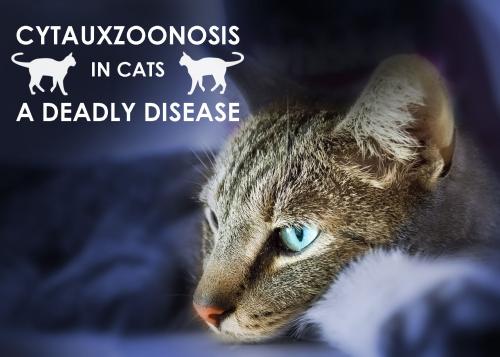Cytauxzoonosis In Cats

Cytauxzoonosis In Cats
Cytauxzoonosis is a tick-borne parasitic disease caused by Cytauxzoon felis, a protozoan organism. C. Felis infects the cat's blood cells. It was first identified in the USA in 1976 and is now a major emerging disease in domestic cats.
The natural host of this parasite is the bobcat, but the parasite can infect all other members of the cat family, both domestic and wild. Although most bobcats display no apparent signs of disease, infected bobcats become chronic carriers of the disease.
The infection spreads to other cats through the bite of a tick — usually the Lone Star tick. While other forms of ticks may bite cats, the only other species that has been shown to spread the infection experimentally is the American dog tick. Cats are unable to receive the infection directly from the infected animal.
Symptoms
It may take one to two weeks after exposure to a cat's parasite to begin symptoms. The first symptoms of infestation are typically loss of appetite and the initiation of pain vocalizations. Signs that you need to look out for include:
- Jaundice
- Enlarged lymph nodes
- Enlarged liver and spleen
- Hypothermia
- Increased vocalization
- Fluid in the lungs
- Anemia
- Coma
- Pyrexia
- Lethargy
- Depression
- Anorexia
- Dehydration
Diagnosis
The diagnosis of cytauxzoonosis is based on history , physical examination and laboratory tests. A complete blood count may display a decrease in the number of red blood cells, white blood cells, and/or platelets. Microscopic blood test can show Cytauxzoon felis in red blood cells or white blood cells. The blood test for polymerase chain reaction (PCR) is also used to diagnose the disease.
VetScan Flex4 Rapid Test (which also tests for ehrlichia, anaplasmosis, and heartworm)– also determine whether or not your cat has been exposed to a tick-borne parasitic disease.
Treatment
Treatment is administered for 10 days. Supportive care is important during the treatment process as these cats are seriously ill. Intravenous fluids, pain killers, anti-nausea drugs and aggressive dietary assistance are vital aspects of treatment, as these supportive interventions keep the cat safe while anti-protozoal drugs and the cat's own immune system are functioning. Severely anaemic cats may need a blood transfusion. Cats lucky enough to recover from illness are apparently immune from having the disease again; however they can continue to carry the parasite in their red blood cells for months or years.
Prevention
No vaccine is currently available or under production. Prevention focuses on preventing tick bites by regular use of acaricides and keeping cats in endemic areas indoors to minimize exposure. Recovered carrier cats should also be secured with acaricides and indoor containment in order to reduce the risk of transmission of their infection to naive ticks. Treatment with atovaquone-azithromycin can also be helpful to minimize transmission by minimizing parasitemia.
Post Your Ad Here
Comments